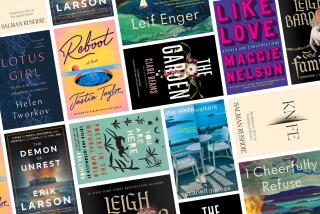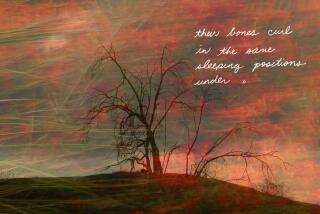‘The Ballad of Dorothy Wordsworth’ by Frances Wilson
The Ballad
of Dorothy Wordsworth
A Life
Frances Wilson
Farrar, Straus & Giroux: 318 pp., $30
Literature is supposed to be a serious, solitary profession. Then why were William Wordsworth, his sister Dorothy and their best friend Samuel Coleridge having so much fun together in the English Lake District in 1798?
The three of them were inseparable, wandering the countryside together, Coleridge often high on opium and the Wordsworths tripping on nature. In “The Prelude,” Wordsworth would later recollect that they “wantoned in wild poesy.” They walked for miles every day, talking to beggars, communing with birds and flowers, and lying in ditches staring into the sky. The two men produced an amazing body of work in this annus mirabilis that they published jointly in “Lyrical Ballads.” Wordsworth’s ballads about the lives of the rural poor and Coleridge’s visionary poems such as “The Rime of the Ancient Mariner” enlarged the discourse and transformed the aesthetic and language of English poetry.
But what about Dorothy? She plied her pen as assiduously as the men, keeping a journal of their life together that remains one of the masterpieces of spontaneous English prose, which both her brother and (to a lesser extent) Coleridge raided for stories, images and ideas. Dorothy observed everything around her with a candid, penetrating eye and wrote about it with rare delicacy, but she revealed only stray, usually opaque glimpses of her state of mind. As a result, although we know the intimate details of her domestic life for years on end, she remains one of the most enigmatic figures in English literature.
In “The Ballad of Dorothy Wordsworth,” British biographer Frances Wilson undertakes a close reading of the journals to reconstruct the inner life of this rustic revolutionary. Wilson, the author of “Literary Seductions,” a study of obsessive sexual relationships between writers such as Henry Miller and Anaïs Nin, makes a strong case for taking a fresh look at Dorothy Wordsworth. Early biographers portrayed her as a seraphic creature of quivering sensibility, sexless and selfless; later, she fit easily into the feminist template of the exploited victim. Wilson dives deep and headlong into the journals, applying various modern psychological and medical hypotheses. She comes up with some fascinating insights, such as the possibility that Dorothy’s frequent perception of the hills and lakes as sparkling was a symptom of a migraine coming on. More often, though, Wilson leaps wildly.
“The Ballad of Dorothy Wordsworth” is a book in search of a Bold Theory. Sometimes Wilson seems to be pushing herself toward incest, but as weirdly close as the Wordsworth siblings were, the record simply can’t support that hypothesis. Wilson’s readings are often entertaining and sometimes ingenious, but she never pulls them together into a coherent system. It’s not for want of trying: She applies herself diligently to the task of being “irreverent” and “provocative,” as she digs up unsuspected layers of meaning.
For Wilson, a cigar is never just a cigar. Nothing simply says what it says; every word must hold a clue, a reflection of Dorothy’s tortured inner life. When Dorothy changes the phrase “foot of the lake” to “margin of the lake,” Wilson sees in this Dorothy’s “sense of frames, limits, borders.” Leaping is fine, but to arrive anywhere it must be grounded in a precise, sensitive reading of the text. In 1802, “margin” was the common word for land at the edge of a body of water; “foot” implies a lower position, as next to a hill. Dorothy was just making a tiny correction.
Wilson’s theorizing zeal on one occasion leads her into something very like intellectual dishonesty when, in the first chapter, she deceptively misquotes one of the most controversial passages in the journals. On the night before her brother’s wedding, Dorothy wore the wedding ring that Wordsworth would give his bride. Before he set off for the ceremony, Wilson quotes Dorothy, “I took it from my forefinger where I had worn it the whole of the night before -- he slipped it again onto my finger & blessed me fervently.”
More than a hundred pages later, Wilson reveals that this is a faulty transcription of a line that Dorothy had blotted out, as it was published in 1958. A recent scholar reexamined the journal page and discovered that the line should read, “he slipped it again onto my finger as I blessed it softly,” which is now the generally accepted text. Wilson chooses to quote a discredited reading, which she herself rejects, presumably because it’s juicier. She excuses the 1958 misreading as a “Freudian slip” and even runs through other uses of “fervent” words in the journals -- providing a thorough textual analysis of a text Dorothy Wordsworth didn’t write.
Wilson is at her weakest when she writes about Wordsworth’s poetry, the center of Dorothy’s conscious mental life. Wilson’s remarks on the poetry are cursory and sometimes almost flippant. (Coleridge comes off better.) She quotes Dorothy’s enchanting account of discovering a field of daffodils, then describes “I Wandered Lonely as a Cloud,” Wordsworth’s most famous poem, as his “tidied-up account of the walk,” with not a word more. Irreverent, provocative: check. Many readers may be content to see this anthology war horse, widely available in embroidery kits and refrigerator magnets, yanked off its pedestal, yet still believe it’s worth taking seriously.
Wilson’s main interest in Wordsworth’s poetry is to find odds and ends that support her speculations about Dorothy’s inner life. Yet if the poetry that was at the core of Dorothy’s existence doesn’t command our attention, then why should we care about her mental state? Dorothy Wordsworth’s journals have enormous interest in their own right, for their detailed picture of rural life and exquisite observations of nature, but they gain a vastly heightened significance because of the essential role that their author played in her brother’s growth as an artist: She was his collaborator in an even deeper sense than Coleridge was. Put another way, if William Wordsworth had been a butcher, few modern readers would care about Dorothy’s daffodils, lovely as they are.
James is the author of “The Snake Charmer: A Life and Death in Pursuit of Knowledge.”
More to Read
The biggest entertainment stories
Get our big stories about Hollywood, film, television, music, arts, culture and more right in your inbox as soon as they publish.
You may occasionally receive promotional content from the Los Angeles Times.










